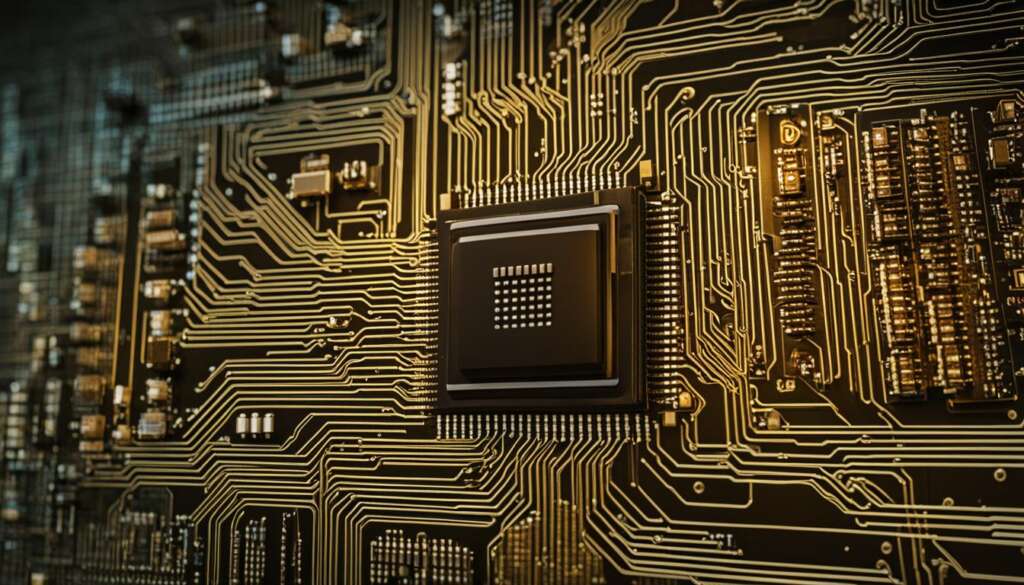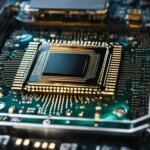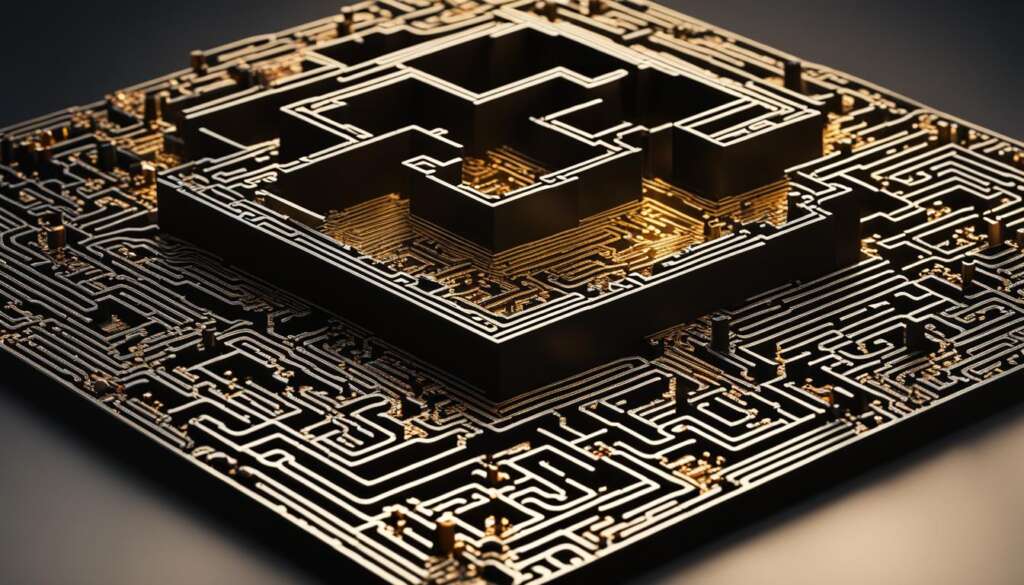Table of Contents
Welcome to our exploration of the fascinating history of microprocessors. In this article, we will take a journey through time to uncover the origins and evolution of these revolutionary technological marvels. From their humble beginnings to the present-day powerhouses, microprocessors have shaped the world of computing as we know it.
Much like the intricate circuits they contain, the history of microprocessors is a complex tapestry of innovation, ingenuity, and relentless progress. Let’s delve into the captivating story of how these tiny chips came to be and the significant milestones that have marked their timeline.
Join us as we embark on a journey through time, discovering the pioneers, breakthroughs, and advancements that have shaped the history of microprocessors. From the pioneering work of Fairchild Semiconductors to the game-changing introduction of the Intel 4004, the world’s first microprocessor, we will unravel the fascinating tales behind these remarkable technological achievements.
Throughout this article, we will explore the evolution of microprocessors, from the 4-bit Intel 4004 to the high-performance 64-bit processors of the fifth generation. We will also delve into the contributions of key figures such as Marcian “Ted” Hoff, the architect of the Intel 4004, and the revolutionary impact microprocessors have had on various industries.
So, fasten your seatbelts as we embark on this captivating journey through the history of microprocessors. Join us as we uncover the origins, milestones, and future prospects of these game-changing computational wonders. Stay tuned for an enlightening exploration of the microprocessor timeline and witness the enduring legacy of these remarkable chips.
The Evolution of Microprocessors: 1st Generation
In the period between 1971 and 1973, the first generation of microprocessors burst onto the scene, paving the way for future innovations in computing technology. At the forefront of this revolution was the Intel 4004, a groundbreaking invention that marked a significant milestone in microprocessor development.
The Intel 4004, introduced in 1971, may have been a 4-bit microprocessor with limited capabilities, but its impact cannot be underestimated. It was primarily used for controlling devices due to its small word size, making it suitable for applications in areas such as calculators and simple digital devices.
The birth of the first microprocessor laid the foundation for further advancements in the field. It opened up new possibilities and sparked a wave of innovation, igniting the passion of engineers and scientists to push the boundaries of microprocessor technology.
The First Generation of Microprocessors: A Snapshot
To gain a better understanding of the first generation of microprocessors, let’s take a closer look at a comparative table showcasing key specifications:
| Microprocessor | Word Size | Introduction Year | Main Applications |
|---|---|---|---|
| Intel 4004 | 4-bit | 1971 | Calculators, digital devices |
| … | … | … | … |
As the table illustrates, the first generation of microprocessors set the stage for future advancements, showcasing the initial steps taken towards the development of more sophisticated and powerful processors. While they may have been limited in capabilities compared to their successors, these early microprocessors laid the foundation for the technology-driven world we live in today.
The Evolution of Microprocessors: 2nd Generation
In the second generation of microprocessors, significant advancements were made in terms of microprocessor development, innovation, and evolution. This era saw the introduction of the Intel 8008 and 8080 microprocessors, both of which were 8-bit processors. These microprocessors built upon the foundation laid by their predecessors and offered improved performance and capabilities.
The Intel 8008, released in 1972, was the first 8-bit microprocessor from Intel. It had a clock speed of 200kHz and was primarily used in control applications. The Intel 8080, introduced in 1974, further pushed the boundaries of microprocessor technology. With a clock speed of 2MHz, it offered enhanced performance and was widely adopted in early personal computers and other computing devices.
During the second generation, microprocessor development was not limited to Intel. Competing manufacturers, such as Motorola and Zilog, also released their own 8-bit microprocessors. The Motorola 6800 and the Zilog Z-80 were popular alternatives to Intel’s offerings. These microprocessors found applications in a variety of devices, including home computers, arcade games, and industrial control systems.
To gain a better understanding of the advancements made during the second generation of microprocessors, let’s take a closer look at a comparative table:
| Microprocessor | Year of Introduction | Word Size | Clock Speed |
|---|---|---|---|
| Intel 8008 | 1972 | 8-bit | 200kHz |
| Intel 8080 | 1974 | 8-bit | 2MHz |
| Motorola 6800 | 1974 | 8-bit | 1MHz |
| Zilog Z-80 | 1976 | 8-bit | 2.5MHz |
As the table illustrates, the second generation of microprocessors saw improvements in terms of clock speed and word size. These advancements paved the way for more sophisticated applications and set the stage for further innovations in subsequent generations.
The Evolution of Microprocessors: 3rd Generation
In the late 1970s, the microprocessor industry entered its third generation, marked by significant advancements in microprocessor development, innovation, and evolution. During this era, microprocessors transitioned from 8-bit to 16-bit architecture, bringing about a new era of computing capabilities.
The standout microprocessor of the third generation was the Intel 8086, released in 1978. With a 16-bit word size, the 8086 offered improved computational power and expanded memory addressing capabilities. This breakthrough allowed for more complex and sophisticated applications, such as high-performance gaming, graphic design, and scientific calculations.
Motorola also made its mark in the third generation with the release of the 68000 microprocessor. Similar to the Intel 8086, the 68000 featured a 16-bit architecture, delivering enhanced performance and versatility. The 68000 found success in both personal computers and embedded systems, further driving the evolution of microprocessor technology.
The Advancements of the 3rd Generation Microprocessors
The third generation of microprocessors brought several notable advancements:
- Increased word size: The transition from 8-bit to 16-bit architecture enabled more sophisticated data processing and improved memory capabilities.
- Expanded memory addressing: The larger word size allowed for addressing larger amounts of memory, empowering developers to create more memory-intensive applications.
- Enhanced performance: The 16-bit architecture provided a significant boost in computational power, enabling faster and more efficient data processing.
- Wider range of applications: With improved capabilities, third-generation microprocessors found applications in areas such as gaming, graphical design, and scientific calculations.
The third generation of microprocessors laid the groundwork for further advancements and set the stage for the future of computing. The increased word size and enhanced performance opened doors to new possibilities, paving the way for the fourth generation of microprocessors that would bring even more power and capabilities to the world of technology.
| Microprocessor | Year | Word Size |
|---|---|---|
| Intel 8086 | 1978 | 16-bit |
| Motorola 68000 | 1979 | 16-bit |
The Evolution of Microprocessors: 4th Generation
In the early 80s, the fourth generation of microprocessors ushered in a new era of technological advancement. Intel introduced the Intel 80386, a 32-bit microprocessor that revolutionized computing capabilities. With a larger word size and improved computational power, the 80386 enabled faster and more complex operations, making it ideal for a wide range of applications.
Not to be outdone, Motorola released the 68020, a 32-bit microprocessor that also contributed to the rapid development of computing technology. These fourth-generation microprocessors played a significant role in the rise of personal computers and facilitated more efficient and sophisticated number crunching operations.
Table:
| Microprocessor | Word Size | Year Released |
|---|---|---|
| Intel 80386 | 32-bit | 1985 |
| Motorola 68020 | 32-bit | 1984 |
“The introduction of the Intel 80386 and Motorola 68020 marked a significant leap forward in microprocessor development. These 32-bit processors offered improved performance and expanded capabilities, paving the way for more complex computing tasks and driving innovation in various industries.”
The fourth generation of microprocessors set the stage for further advancements in technology. Their increased power and efficiency opened up new possibilities for software development, allowing for the creation of more sophisticated applications and systems.
As the world entered the era of the fourth-generation microprocessors, the possibilities seemed endless. The rapid evolution of these chips continued to shape the future of computing, leading to even more powerful and groundbreaking microprocessors in the years to come.
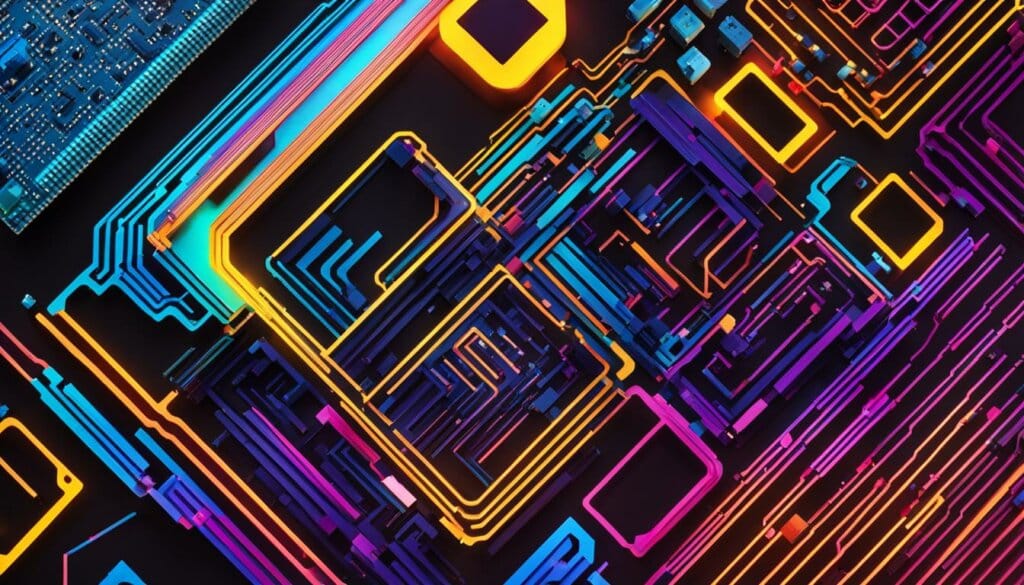
The Advantages of 4th Generation Microprocessors
The fourth generation of microprocessors brought several advantages and improvements over their predecessors. Here are some of the key benefits:
- Increased computational power: The 32-bit architecture of these microprocessors allowed for faster and more complex calculations, enabling more advanced software applications.
- Enhanced multitasking capabilities: With their improved performance, the fourth-generation microprocessors offered better multitasking support, allowing users to run multiple applications simultaneously without significant slowdowns.
- Expanded memory addressing: The larger word size of 32 bits expanded the memory addressing capabilities of these microprocessors, enabling access to larger amounts of memory and fostering the development of more memory-intensive applications.
- Better graphics and multimedia support: The increased processing power of the fourth-generation microprocessors facilitated the development of more advanced graphics and multimedia applications, leading to improved visual experiences and enhanced multimedia capabilities.
The Evolution of Microprocessors: 5th Generation
Starting from 1995, the fifth generation of microprocessors marked a significant milestone in the development of these powerful chips. With the advent of 64-bit technology, microprocessors achieved unprecedented levels of performance and speed. This breakthrough propelled computing capabilities beyond the confines of older mainframe computers, all while being available at a fraction of the cost. The fifth-generation microprocessors paved the way for a new era of computing, revolutionizing technology across various industries.
The 64-bit architecture of these microprocessors allowed for enhanced computational power and expanded memory capabilities. This, in turn, facilitated the execution of complex tasks, from advanced gaming and multimedia applications to data-intensive calculations. The fifth-generation microprocessors became the driving force behind the rapid evolution of personal computers, enabling a wide range of applications and creating a more immersive computing experience.
With 64-bit technology, microprocessors in the fifth generation revolutionized the computing landscape. They brought incredible power and performance to the masses, making high-speed computing accessible to more users than ever before.
The fifth generation also witnessed the rise of specialized microprocessors tailored for specific industries and applications. From powerful graphic processing units (GPUs) for gaming and multimedia, to microcontrollers for embedded systems, microprocessors continued to innovate and shape the technological landscape. These advancements opened up new possibilities in fields such as medical devices, automotive systems, and smart appliances, where microprocessors played a crucial role in enabling advanced functionality and connectivity.
The Advantages of 5th Generation Microprocessors:
- Unprecedented performance and speed
- 64-bit architecture for enhanced computational capabilities
- Expanded memory capacities
- Improved gaming and multimedia experiences
- Specialized microprocessors for specific industries and applications
- Enablement of advanced functionality and connectivity
Overall, the fifth generation of microprocessors propelled technology forward with their unparalleled performance and advanced capabilities. From powering personal computers to driving innovation in various industries, these microprocessors continue to evolve and shape the future of computing.
| Microprocessor | Year |
|---|---|
| Intel Pentium | 1993 |
| AMD K5 | 1996 |
| Intel Pentium Pro | 1995 |
| AMD K6 | 1997 |
Marcian “Ted” Hoff: The Architect of the First Microprocessor
Marcian “Ted” Hoff is widely recognized as the visionary architect behind the development of the first microprocessor, the Intel 4004. Hoff’s groundbreaking work at Intel revolutionized the world of computing and paved the way for the modern microprocessors that we rely on today.
Born in Rochester, New York, in 1937, Hoff displayed an early aptitude for mathematics and engineering. He pursued a degree in electrical engineering at Rensselaer Polytechnic Institute and later earned his Ph.D. in the same field from Stanford University.
In 1968, Hoff joined Intel and became part of a team tasked with finding a solution for the growing demand for computer power in a more compact form. It was through Hoff’s innovative thinking and design that the Intel 4004, the first commercially available microprocessor, was born in 1971.
“We wanted to integrate the functions of a computer onto a single chip, making computing power more accessible and affordable,” Hoff explained.
With the introduction of the Intel 4004, the era of microprocessors began, transforming the landscape of computing and leading to the development of smaller, faster, and more powerful computers. Hoff’s contribution laid the foundation for the history of microprocessors, enabling technological advancements that have shaped our world ever since.
| Key Contributions | Year |
|---|---|
| Architect of the Intel 4004 | 1971 |
| Pioneered the concept of a single-chip microprocessor | 1971 |
| Revolutionized computing by making it more accessible and affordable | 1971 |
Hoff’s work and the subsequent advancements in microprocessor technology have propelled the growth of various industries, from personal computing to telecommunications, automotive, aerospace, and beyond. His role as the architect of the first microprocessor solidifies his place in the history of technology as one of the industry’s most significant innovators.
Microprocessors Revolutionizing Technology
Microprocessors have revolutionized technology, from personal computers to embedded systems. These powerful chips have enabled a wide range of applications in various industries, driving advancements and innovation. With each generation, microprocessors have become faster, smaller, and more efficient, opening up new possibilities and transforming the way we live and work.
One of the key advancements in microprocessor technology is the continuous increase in processing power. As microprocessors have become more sophisticated, they have been able to handle increasingly complex calculations and tasks. This has led to significant improvements in areas such as artificial intelligence, data analysis, and graphics processing. High-performance microprocessors are now capable of handling massive amounts of data and performing complex computations in real-time, making them invaluable in fields like scientific research, finance, and gaming.
Another area where microprocessors have made a profound impact is in the field of embedded systems. These are specialized computer systems designed to perform specific functions within larger devices or machinery. From automotive systems to medical devices, microprocessors are at the heart of countless embedded systems, providing precise control, monitoring, and data processing capabilities. This has revolutionized industries such as healthcare, transportation, and manufacturing, enabling the development of advanced technologies and improving efficiency and safety.
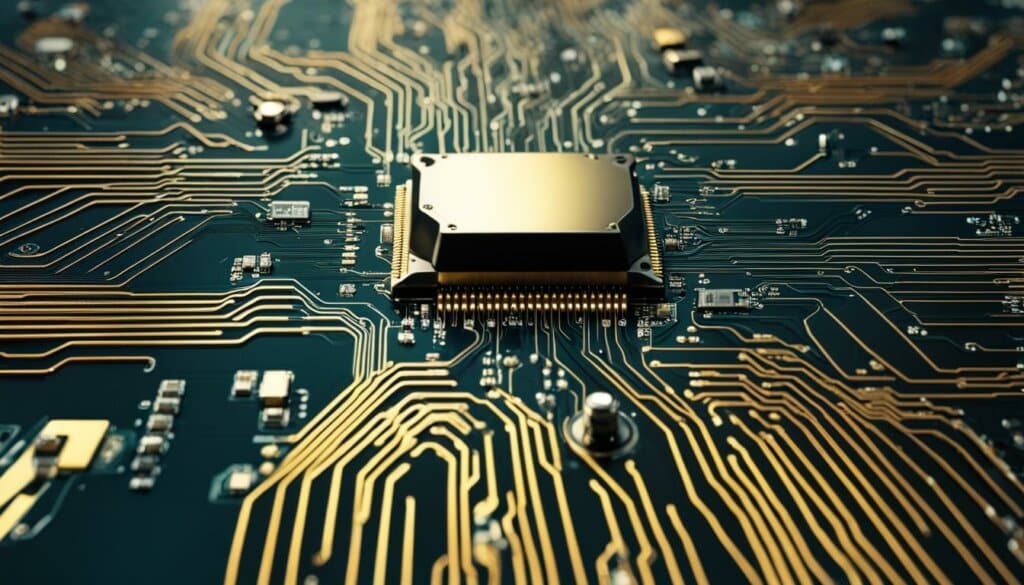
The Future of Microprocessors
Looking ahead, microprocessors are set to continue their advancement and shape the future of technology. The development of new materials, such as graphene, could lead to even smaller and more powerful microprocessors. Additionally, breakthroughs in quantum computing could revolutionize the field, offering unprecedented processing capabilities.
As microprocessors become more integrated into our daily lives, their potential for transforming technology and driving innovation is limitless. From smart homes and wearable devices to autonomous vehicles and robotics, microprocessors will continue to play a vital role in shaping the technology of tomorrow.
| Industry | Applications |
|---|---|
| Healthcare | Medical imaging, patient monitoring systems, diagnostic equipment |
| Transportation | Automotive systems, navigation and GPS, electric vehicles |
| Manufacturing | Industrial automation, robotics, quality control systems |
| Communication | Mobile devices, wireless communication, network infrastructure |
Conclusion
The history of microprocessors is a fascinating journey that showcases the rapid advancement of technology. It all began with the invention of the first integrated circuit by Fairchild Semiconductors in 1959, paving the way for the birth of microprocessor history. Intel’s introduction of the first microprocessor, the Intel 4004, in 1971 marked a significant milestone in the evolution of these powerful chips.
Over the years, microprocessors have undergone remarkable transformations. From the 4-bit Intel 4004 to the 64-bit processors of the fifth generation, these chips have continually revolutionized technology. They have become the backbone of personal computers, embedded systems, and countless other devices, enabling faster computations and expanding the possibilities of various industries.
Marcian “Ted” Hoff, the architect of the Intel 4004, played a pivotal role in shaping the microprocessor landscape. His contributions to the development of this groundbreaking chip set a course for the future of computing, inspiring countless engineers and scientists to push the boundaries of what is possible.
In conclusion, the history of microprocessors is a testament to human ingenuity and the power of innovation. These chips have not only transformed the world of computing but have also become an integral part of our daily lives. As technology continues to advance, we can expect microprocessors to play an even more significant role in shaping the future.
Related Articles:
For those interested in exploring more about this fascinating topic, a wealth of information awaits:
- Curious about what the future holds for microprocessors? Explore the advancements and potential developments in What are the Future Trends in Microprocessor Technology?
- Discover how microprocessors have reshaped consumer electronics in How has the Evolution of Microprocessors Influenced Modern Consumer Electronics?
- Learn about the visionaries who pioneered this field in Who were the Key Figures in the Early Days of Microprocessor Technology?
- Delve into the technical hurdles overcome during the early development stages in What were the Technological Challenges in the Development of the Microprocessor?
- Understand the broader impact of this invention on computing in How did the Invention of the Microprocessor Change the Course of Computing?
These articles offer a deeper dive into the fascinating world of microprocessors, providing insights into their past, present, and future.
FAQ
Who invented the first microprocessor?
The first microprocessor was invented by Fairchild Semiconductors, however, Marcian “Ted” Hoff is credited with being the architect of the first microprocessor, the Intel 4004.
When was the first microprocessor invented?
The first microprocessor was invented in 1959 by Fairchild Semiconductors, marking the beginning of microprocessor history. The Intel 4004, the first commercially available microprocessor, was introduced in 1971.
What is the difference between a microprocessor and a central processing unit (CPU)?
A microprocessor and a central processing unit (CPU) are often used interchangeably. A microprocessor is a single chip that contains various peripherals such as an arithmetic and logic unit (ALU), control unit, registers, bus systems, and a clock. It is the main component of a computer system that executes instructions and performs calculations. A CPU, on the other hand, refers to the physical device that houses the microprocessor.
How did microprocessors revolutionize technology?
Microprocessors have revolutionized technology by providing faster and more powerful processors in increasingly smaller packages. This has led to the development of personal computers, embedded systems, and a wide range of applications in various industries. The continuous advancement of microprocessor technology has driven innovation and transformed the world of computing.
What is the current generation of microprocessors?
The current generation of microprocessors is the fifth generation, which utilizes 64-bit technology to deliver high-performance and high-speed processors. These processors have surpassed the computing power of older mainframe computers and are available at a fraction of the cost.
Who played a key role in the development of the first microprocessor?
Marcian “Ted” Hoff, who joined Intel in 1968, played a key role in the development of the first microprocessor, the Intel 4004. Hoff is credited with being the architect of this groundbreaking invention.
How have microprocessors advanced over time?
Microprocessors have advanced over time by increasing in word size and computational capabilities. The first generation of microprocessors had limited word sizes and capabilities, primarily used for controlling devices. Subsequent generations introduced larger word sizes and improved computational power, enabling a wider range of applications, including number crunching operations.
What industries have been impacted by microprocessors?
Microprocessors have impacted various industries, including personal computers, telecommunications, automotive, aerospace, healthcare, and many more. Their versatility and computational power have enabled advancements in these industries, leading to increased efficiency and innovation.
What is the significance of the history of microprocessors?
The history of microprocessors is significant as it highlights the rapid advancement of technology and its impact on society. From the pioneering work of Fairchild Semiconductors and Intel to the present-day high-performance microprocessors, these chips have transformed the world of computing and continue to drive innovation in various industries.

